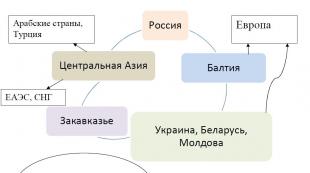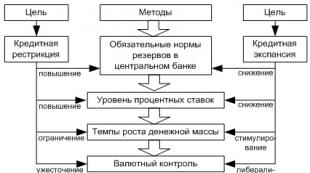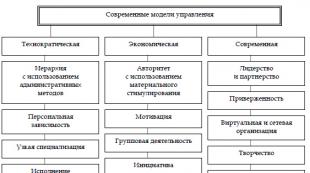The main stages of the conflict. Conflict management and ways to improve methods of their resolution Sequence of stages of conflict development
Social psychology distinguishes 4 main stages of the conflict: the pre-conflict stage, the conflict itself, the stage of resolving contradictions and the post-conflict stage.
Pre-conflict stage of the conflict
At this stage, a certain situation arises in which tension in relations between potential participants in the conflict grows. It is due to already existing contradictions.
For example, the boss asked the employee to do overtime work, which is not part of the direct duties of the employee. The employee is unhappy that he will have to spend his day off on this task, because the last time such overtime work was not additionally paid. Further, he may confine himself to his dissatisfaction, but do the work and then the conflict will not come, or he may openly declare his refusal, which is likely to lead to an increase in conflict.
Direct conflict
At this stage, the parties to the conflict begin to confront each other. An incident occurs, that is, the very first clash of the conflicting parties. In our example, the first open refusal of an employee to perform overtime work can be considered such an incident. The boss, in turn, threatens to deprive the employee of the bonus for refusing to obey. There is a confrontation between the parties.
The confrontation can enter the escalation stage, that is, continue to grow, or remain at the same level. For example, in the event of an escalation, the employee will respond to the boss that he will contact the union. If the conflict remains at the same level, then the employee will simply leave, slamming the door.
If the escalation continues, then eventually it leads to such a confrontation, when the very cause of the conflict is no longer important for the participants. It is only important to cause maximum damage to the opponent.
Conflict resolution stage
This stage is the most difficult for all participants in the conflict. They will have to reevaluate their relationship and find ways to resolve the problem.
- What will be the cost of energy, effort, time, money. If the conflict continues?
- What damage will be done to both sides?
- What losses will they suffer?
For example, the boss objectively understands that the employee is important to the company and his dismissal will do more harm than good. At the same time, the employee understands that further confrontation will lead to the impossibility of career growth. The parties to the conflict decide to agree. The employee agrees to do the overtime, and the boss agrees to pay extra for it.
Post-conflict stage
After the end of the conflict, each of the participants leaves a trace in the emotional state of the opponents: resentment and disappointment or pride in their actions. The relationship between the conflicting parties is changing and will no longer be the same as it was before the conflict began.
Reading time: 2 min
stages of conflict. Sociologists argue that conflict interaction is a normal state of society. After all, any society, regardless of the era, is characterized by the presence of situations of confrontation. Even when interpersonal interaction is built harmoniously and is based on mutual understanding, clashes are inevitable. So that confrontations do not destroy the life of society, so that public interaction is adequate, it is necessary to know the main stages of the development of the conflict, which will help to identify the moment of the onset of confrontation, effectively smooth out sharp corners in disputes and disagreements. Most psychologists recommend using confrontation as a source of self-learning and life experience. Analysis conflict situation allows you to learn more about your own person, the subjects involved in the confrontation and the situation that provoked the confrontation.
Stages of conflict development
It is customary to distinguish four concepts of the stage of development of conflicts: the pre-conflict stage, the conflict itself, the stage of resolving the contradiction and the post-conflict stage.
So, the main stages of the conflict: the pre-conflict stage. It begins with a pre-conflict situation, since any confrontation is initially preceded by an increase in tension in the interaction of potential subjects of the conflict process, provoked by certain contradictions. At the same time, not all contradictions and not always lead to conflict. Only those discrepancies entail a conflict process, which are recognized by the subjects of confrontation as an opposition of goals, interests and values. Tension is a psychological state of individuals, which is latent before the start of the conflict process.
Dissatisfaction is considered one of the key factors in the emergence of conflicts.
The accumulation of dissatisfaction due to the status quo or the development of events leads to an increase in tension. A potential subject of conflict confrontation, dissatisfied with the objectively established state of affairs, finds the alleged and real culprits of his dissatisfaction. At the same time, the subjects of a conflict encounter understand the insolubility of the formed situation of confrontation by the usual methods of interaction. In this way, the problematic situation gradually develops into a clear collision. At the same time, a disputable situation can exist regardless of subjective-objective conditions for a long time without transforming directly into a conflict. In order for the conflict process to start, an incident is needed, that is, a formal pretext for the emergence of a direct clash of participants. An incident may appear by chance or be provoked by the subject of a conflict confrontation. Moreover, it can also be the result of the natural course of events.
A conflict situation, as a stage in the development of a conflict, is far from always identified, since often a clash can begin directly with a clash of parties, in other words, it begins with an incident.
According to the nature of the origin, four types of conflict situations are distinguished: objective-purposeful and non-purposeful, subjective-purposeful and non-purposeful.
A conflict situation, as a stage of a conflict, is created by one opponent or several participants in the interaction and is most often a condition for the emergence of a conflict process.
As mentioned above, for the occurrence of a direct collision, the presence of an incident, coupled with a situation of confrontation, is necessary. In this case, the situation of confrontation arises before the incident (incident). It can be formed objectively, that is, outside the desire of people, and subjectively, due to the motives of behavior, the conscious aspirations of opposing participants.
The main stages in the development of a conflict are the conflict itself.
The beginning of a clear confrontation between the participants is a consequence of the conflict style of behavioral response, which is understood as actions aimed at the confronting party for the sake of capturing, holding the object of the dispute, or forcing the opponent to change his own intentions or renounce them.
There are four forms of conflict behavior style:
Challenge or active-conflict style;
Challenge response or passive-conflict style;
Conflict-compromise model;
compromising behavior.
The confrontation acquires its own logic and development depending on the problem setting and the style of conflict behavioral response of the participants. The developing confrontation is characterized by a tendency to create additional reasons for its own aggravation and growth. Therefore, each confrontation has its own stages of conflict dynamics and is unique to some extent.
The confrontation can develop according to two scenarios: enter the escalation phase or bypass it. In other words, the dynamics of the development of a collision at the stage of a conflict is denoted by the term escalation, which is characterized by an increase in the destructive actions of the opposing sides. Escalation of conflicts can often lead to irreversible consequences.
Usually, there are three main stages of conflict dynamics that occur at this stage:
The development of confrontation from a latent form into an open clash of opponents;
Further growth (escalation) of the conflict;
The confrontation reaches its peak and takes the form of a general war, which is not shunned by any means.
At the last stage of the conflict, development occurs as follows: the conflicting participants "forget" the real causes of the conflict. For them, the main goal is to cause maximum damage to the enemy.
The main stages of the development of the conflict - the resolution of the confrontation.
The intensity and duration of the confrontation depend on many conditions and factors. At a certain stage of the course of the confrontation, the opposing participants can significantly change their opinion about their own potential and about the capabilities of the opponent. That is, the time has come for a “reassessment of values”, due to the renewed relationships that arose as a result of the conflict, the realization of the exorbitant “cost” of success or the inability to achieve goals. This pushes opponents to transform the tactics and style of conflict confrontation. At this stage, one of the opposing parties or both seek to find ways to resolve the problem situation, as a result of which, as a rule, the intensity of the struggle is on the decline. With this, the process of ending the conflict interaction begins. However, this does not exclude a new aggravation.
The final stage of confrontation is after conflict.
The end of the immediate confrontation of opponents does not always mark the complete resolution of the confrontation. In many respects, the degree of satisfaction of the subjects of conflict interaction or dissatisfaction of the participants with the “concluded peace agreements” is characterized by dependence on the following provisions:
Has the goal pursued by the conflict been achieved, and to what extent is it satisfied;
By what means and methods was the confrontation waged;
How great is the damage of the parties (for example, material);
How high is the degree of infringement of the dignity of opponents;
Was it possible to eliminate the emotional tension of the participants during the conclusion of the “peace”;
What methods were the basis of negotiation interaction;
To what extent it was possible to coordinate the interests of the participants;
Whether the compromise solution was imposed as a result of coercion or was the result of mutual finding a way to resolve the conflict;
What is the reaction of the social environment to the results of the conflict.
Stages of social conflict
Taking a direct part in the confrontation, it is quite difficult to abstract and think about something else, since often the divergence of views is quite sharp. At the same time, observers of confrontation can easily identify the main stages of social conflict. Sociologists usually disagree on the number of stages of social confrontation. But all of them are similar in the definition of social confrontation. In a narrow sense, social confrontation is a confrontation caused by disagreements between social communities in the justification of labor activity, a general deterioration in the economic condition and status situation, or in comparison with other teams, a decrease in the level of satisfaction with joint activities. A characteristic sign of social confrontation is the existence of an object of confrontation, the possession of which is associated with individuals involved in social confrontation.
The main stages of social conflict: latent (hidden growth of discontent), peak of social tension (clear expression of confrontation, active actions of the participants), resolution of the collision (reduction of social tension by overcoming the crisis).
The latent stage marks the stage of the emergence of the conflict. Often it is not even visible to an outside observer. All actions of this stage develop at the social and psychological level.
Examples of the stage of the conflict - origin (talks in smoking rooms or offices). The growth of this phase can be traced by a number of indirect signs. At the latent stage of the conflict, examples of signs can be given as follows: an increase in the number of absenteeism, layoffs.
This stage can be quite lengthy in duration.
The peak phase is the critical point of opposition. At the peak stage of the course of the conflict, the interaction between the opposing sides reaches the utmost sharpness and intensity. It is important to be able to identify the passage of this point, since the situation of confrontation after its peak, as a rule, is manageable. At the same time, sociologists argue that intervention in a collision at the peak phase is useless, often even dangerous.
At the peak stage of the conflict, examples include the following: armed mass uprisings, territorial disagreements between the powers, strikes.
The fading of the confrontation occurs either due to the exhaustion of the resources of one of the parties involved, or the achievement of an agreement.
Stages of conflict resolution
Social confrontation will be observed until obvious and clear conditions arise for its completion. An external sign of the end of the conflict may be the end of the incident, which means the end of the conflict interaction between the subjects of the confrontation. Completion of conflict interaction is considered a necessary, but not sufficient condition for the extinction of confrontation. Because under certain circumstances, an extinguished conflict can ignite again. In other words, the situation of not fully resolved conflict provokes its resumption on the same foundation or due to a new reason.
However, the incomplete resolution of the confrontation still cannot be considered as a detrimental action. Often it is caused objectively, since not every collision is resolved on the first try and forever. On the contrary, human existence is filled with conflicts that are resolved either temporarily or partially.
The concepts of the stage of conflicts enable the subjects of confrontation to outline the most appropriate behavioral model.
The stage of confrontation resolution involves the following variations in the development of the situation:
The clear superiority of one subject of interaction allows him to impose his own conditions for the completion of the collision on the opponent;
The struggle may drag on until the surrender of one of the participants;
Due to the scarcity of resources, the struggle takes on a long, sluggish character;
Having used all the resources, without revealing the indisputable winner, the subjects make concessions;
The confrontation can be terminated under pressure from a third party.
The stage of resolving conflict interaction with the ability to regulate the confrontation can and even should begin before the actual conflict arises. To this end, it is recommended to use the following forms of constructive resolution: collective discussion, negotiations, etc.
There are many ways to constructively end the confrontation. For the most part, these methods are aimed at modifying the very situation of confrontation; they also apply the impact on the subjects of the conflict or change the characteristics of the conflict object.
Speaker of the Medical and Psychological Center "PsychoMed"
10. Characteristics of the stages (stages) of the development of the conflict.
Usually, four stages of development are distinguished in social conflict:
1. Pre-conflict stage - it is the growth of tension in relations between potential subjects of the conflict, caused by certain contradictions. But contradictions do not always develop into conflict. Only those contradictions that are recognized by potential subjects of the conflict as incompatible lead to an aggravation of social tension.
Social tension is also not always a harbinger of conflict. This is a complex social phenomenon, the causes of which can be very different. Causes, causing the growth of social tension: 1.Real infringement of the interests, needs and values of people.
2. Inadequate perception of changes taking place in society or individual social communities.
3. Incorrect or distorted information about certain (real or imaginary) facts, events, etc.
Social tension, in fact, is the psychological state of people and before the start of the conflict is latent (hidden) in nature. Group emotions are the most characteristic manifestation of social tension during this period. A certain level of social tension in an optimally functioning society is a natural protective and adaptive reaction of the social organism. However, exceeding the optimal level of social tension can lead to conflicts.
Three phases of the pre-conflict stage:
The emergence of contradictions about a certain controversial object; growth of distrust and social tension; presentation of unilateral or mutual claims; reduction of contacts and the accumulation of resentment.
The desire to prove the legitimacy of their claims and the accusation of the enemy of unwillingness to resolve disputed issues by "fair" methods; closing on their own stereotypes; the appearance of prejudice and hostility in the emotional sphere.
Destruction of interaction structures; transition from mutual accusations to threats; growth of aggressiveness; the formation of the "image of the enemy" and the setting for the fight.
Thus, the conflict situation is gradually transformed into an open conflict. But by itself, it can exist for a long time and not develop into a conflict. In order for the conflict to become real, an incident is needed.
Incident - a formal occasion, a case for the start of a direct clash of the parties. An incident can happen by accident, or it can be provoked by the subject (subjects) of the conflict, be the result of a natural course of events. It happens that an incident is prepared and provoked by some third force, pursuing its own interests in the alleged "foreign" conflict.
Three options for the behavior of the conflicting parties in the event of an incident:
The parties (side) strive to settle the contradictions that have arisen and find a compromise.
One of the parties pretends that “nothing special happened” (avoidance of the conflict).
The incident becomes a signal for the beginning of an open confrontation. The choice of one or another option largely depends on the conflict setting (goals, expectations, emotional orientation) of the parties.
2. Stage of development of the conflict - the beginning of an open confrontation of the parties is the result of conflict behavior, which is understood as actions aimed at the opposing side with the aim of capturing, holding the disputed object or forcing the opponent to abandon their goals or to change them. Forms of conflict behavior:
active-conflict behavior (challenge);
passive-conflict behavior (response to a challenge);
conflict-compromise behavior;
compromise behaviour.
Depending on the conflict setting and the form of behavior of the parties, the conflict acquires the logic of development. Developing conflict tends to create additional causes of deepening and expansion. Each new "victim" becomes an "excuse" for the escalation of the conflict. Therefore, each conflict is unique to some extent. Three main phases:
The transition of the conflict from a latent state to an open confrontation of the parties. The struggle is still being waged with limited resources and is local in nature. There is a first test of strength. At this stage, there are still real opportunities to stop the open struggle and resolve the conflict by other methods.
Further escalation of confrontation. To achieve their goals and block the actions of the enemy, new resources of the parties are introduced. Almost all opportunities to find a compromise are lost. The conflict is becoming more and more unmanageable and unpredictable.
The conflict reaches its climax and takes the form of a total war with the use of all possible forces and means. At this phase, the conflicting parties seem to forget the true causes and goals of the conflict. The main goal of the confrontation is to cause maximum damage to the enemy.
3. Stage of conflict resolution . The duration and intensity of the conflict depend on the goals and attitudes of the parties, the resources, means and methods of waging a struggle, the reaction to the conflict of the environment, the symbols of victory and defeat, the available (and possible) methods (mechanisms) for finding consensus, etc.
At a certain stage in the development of the conflict, the opposing sides may significantly change their ideas about the capabilities of their own and the enemy. There comes a moment of reassessment of values, due to new relationships, alignment of forces, awareness of the real situation - the inability to achieve goals or the exorbitant price of success. From this moment, the process of ending the conflict actually begins, which does not exclude new aggravations. Options for the development of events:
the obvious superiority of one of the parties allows it to impose its own conditions for ending the conflict on a weaker opponent;
the struggle goes on until the complete defeat of one of the parties;
the struggle takes on a protracted, sluggish character due to lack of resources;
the parties make mutual concessions in the conflict, having exhausted their resources and not identifying a clear (potential) winner;
the conflict can be stopped under the pressure of a third force.
Ways to end the conflict:
Eliminate the object of conflict.
Replacing one object with another.
Elimination of one side of the parties to the conflict.
Change of position of one of the parties.
Changing the characteristics of the object and subject of the conflict.
Obtaining new information about an object or creating additional conditions.
Prevention of direct or indirect interaction of participants.
The arrival of the parties to the conflict to a single decision or appeal to the arbitrator, subject to submission to any of his decisions.
Negotiation- the final stage of the conflict resolution stage involves negotiations and legal registration of the agreements reached. Negotiations involve a mutual search for a compromise between the conflicting parties and include possible procedures. Recognition of the existence of a conflict.
4. Post-conflict stage . The end of the direct confrontation of the parties does not always mean that the conflict is completely resolved.
The degree of satisfaction or dissatisfaction of the parties with the concluded peace agreements will largely depend on the following provisions:
to what extent it was possible to achieve the pursued goal during the conflict and subsequent negotiations;
what methods and ways the struggle was waged;
how great are the losses of the parties (human, material, territorial, etc.);
how great is the degree of infringement of the self-esteem of one or another side;
whether it was possible, as a result of the conclusion of peace, to relieve the emotional tension of the parties;
what methods were used as the basis of the negotiation process;
to what extent it was possible to balance the interests of the parties;
whether the compromise was imposed by one of the parties or by a third force, or was the result of a mutual search for a solution to the conflict;
what is the reaction of the surrounding social environment to the outcome of the conflict.
If the parties believe that the signed peace agreements infringe on their interests, tensions will continue, and the end of the conflict may be perceived as a temporary respite. Peace, concluded as a result of mutual depletion of resources, is also not always able to resolve the main contentious problems.
The post-conflict stage marks a new objective reality: a new alignment of forces, new relations of opponents to each other and to the surrounding social environment, a new vision of existing problems and a new assessment of their strengths and capabilities.
| " |
No action aimed at preventing or effectively resolving conflicts can be taken if we do not know anything about the causes of their occurrence and the specifics of their development. Therefore, in this lesson the main attention will be paid to consideration of these issues. You will learn about what groups of causes of conflicts exist and how they differ from each other, as well as what are the main stages and stages of their development and what is their dynamics.
Causes of conflicts
In total, four main groups can be distinguished into which the causes of conflicts are divided:
- Objective reasons
- Organizational and managerial reasons
- Socio-psychological reasons
- Personal reasons
Let's talk about each group separately.
Objective causes of conflicts
The objective causes of conflicts are the causes that determine the formation of a pre-conflict situation. In some cases, they may be real, and in some cases they may be imaginary, representing only an occasion artificially invented by a person.
The most common objective reasons include the following:
A clash of spiritual and material interests of people taking place in the process of life in a natural rhythm.
EXAMPLE: Two people are arguing in the store about who will get the product they like, which is left in a single copy.
Insufficiently developed legal norms that regulate conflict resolution of problems.
EXAMPLE: The leader often insults his subordinate. The subordinate, defending his dignity, is forced to resort to conflict behavior. At present, there are no developed effective ways protection from the arbitrariness of the leaders of the interests of subordinates. The subordinate, of course, can file a complaint with the appropriate authorities, but, most likely, this will not work. Hence it turns out that in such situations, subordinates have to either make concessions or enter into conflict.
Insufficient quantity of spiritual and material goods necessary for a normal life and activity.
EXAMPLE: In our time, in society, one can observe all kinds of deficits of various benefits, which will certainly affect both the lives of people and the peculiarities of conflicts between them. Several people can apply for the same promising and well-paid position. This contributes to the emergence of conflicts between people, and the objective cause of the conflict here will be the distribution of material resources..
Organizational and managerial causes of conflicts
Organizational and managerial causes are the second group of causes of conflicts. To some extent, these reasons can be called more subjective than objective. Organizational and managerial reasons are interconnected with such processes as the creation of various organizations, groups, teams, as well as with their functioning.
The main organizational and managerial reasons are:
Structural and organizational reasons- their meaning lies in the fact that the structure of the organization does not meet the requirements that the activity in which it is engaged in puts forward. The structure of the organization should be determined by the tasks that it solves or plans to solve, in other words, the structure must be adapted to them. But the catch is that it is very problematic to bring the structure to the tasks, hence the conflicts arise.
EXAMPLE: When designing the organization, as well as in predicting its tasks, mistakes were made; In the course of the organization's activities, the tasks facing it are constantly changing.
Functional and organizational reasons- usually caused by a lack of optimality in the relationships between the organization and external environment, different departments of the organization or individual employees.
EXAMPLE: Conflicts may arise due to a discrepancy between the rights of the employee and his duties; inconsistency of wages with the quality and quantity of the work done; the discrepancy between the material and technical support and the volume and features of the assigned tasks.
Personal-functional reasons- due to insufficient compliance of the employee, based on the professional, moral and other qualities required by his position.
EXAMPLE: If an employee does not have the qualities required by the organization, conflict relations may arise between him and higher management, colleagues, etc. the mistakes he makes can affect the interests of all with whom he interacts.
Situational and managerial reasons- are the result of mistakes made by managers and their subordinates in the process of the tasks assigned to them (managerial, organizational, etc.).
EXAMPLE: If an incorrect management decision is made, a conflict may arise between its executors and authors; similar situations also arise when the employee did not complete the task assigned to him or did it improperly.
Socio-psychological causes of conflicts
The socio-psychological causes of conflicts are based on the socio-psychological prerequisites laid down in interpersonal relationships. They are also divided into several types:
Unfavorable socio-psychological climate- an environment in which there is no value-oriented unity and a low level of cohesion of people.
EXAMPLE: A negative atmosphere, depression, negative attitude of people towards each other, pessimism, aggression, antipathy, etc. prevail in an organization or any group of people.
Anomie of social norms- this is a mismatch of social norms adopted in an organization or society. It can give rise to double standards - situations where one person requires from others what he himself does not follow.
EXAMPLE: In an organization, there is a person who gets away with everything, and the other is required to perform unthinkable tasks and bear responsibility for every action.
The discrepancy between social expectations and implementation social roles and performance of the functionality- appears due to the fact that one person may have already formed expectations, and the other person may not even be aware of it.
EXAMPLE: The leader expects the subordinate to perform his duties in a specific way, but did not put him in the know. The subordinate performs the work as it should be in his understanding. As a result, the expectations of the leader are not justified, which is the cause of the conflict.
Generation conflict- As a rule, it is associated with different behaviors of people and the difference in their life experience.
EXAMPLE: An elderly person believes that young people should behave in a certain way, corresponding to the idea that is fixed in his mind. Young people, in turn, behave in the way that is right from their point of view. This inconsistency can lead to conflict.
Communication barriers- in other words, misunderstanding between people, which can arise both unconsciously, due to the inability to communicate effectively and focus only on one's own interests, or intentionally, in order to make it difficult for the partner to communicate.
EXAMPLE: threats, teachings, commands, orders, accusations, humiliation, moralizing, logical arguments, criticism, disagreements, interrogations, clarifications, distraction, intentional diversion from the problem and everything that can disrupt the train of thought of another person, force him to prove his position.
Territoriality- refers to the field of environmental psychology. Territoriality refers to the occupation by one person or group of people of a particular space and taking it and everything that is in it under their control.
EXAMPLE: A group of young people come to the park and want to take a bench that people are already sitting on. They demand to give way to them, which can cause a conflict, because. others may not give way. Another example is the introduction of troops into the territory of a country with the aim of occupying certain positions there, subordinating it to one's control, and establishing one's own rules.
The presence of a destructive leader in an informal structure- if there is a destructive leader in an informal organization, he, intending to achieve personal goals, can organize a group of people who will obey his instructions, and not the instructions of a formal leader.
EXAMPLE: You can recall the movie "Lord of the Flies" - according to the plot, the following situation occurred: a group of boys who found themselves on a desert island chose one of the guys as a specific leader. At first, everyone listened to him and carried out his orders. However, later one of the guys felt that the leader was behaving inefficiently. Subsequently, he becomes an informal leader and lures the guys over to his side, as a result of which the boy, who was the formal leader, loses all authority and power.
Difficulties in social and psychological adaptation of new team members- arise in many cases when a new person comes to an organization, company or any other group of people. In such situations, the stability of the team is violated, because of which it becomes subject to negative impact both inside and outside.
EXAMPLE: A new person with his own characteristics and qualities comes to the formed team of the organization department. People begin to look closely, adapt, check each other, arrange all kinds of “tests”. In the process of such interaction, conflict situations of various kinds may arise.
Respondent aggression- is characteristic mainly of weak and defenseless people. It manifests itself in the fact that a person’s indignation is directed not at its source, but at the people around him: relatives, friends, colleagues, etc.
EXAMPLE: The young man works as a manager in a company. But due to his character and personality traits, everyone makes fun of him, “taunts” him, sometimes not quite friendly. But he cannot answer anyone, because. weak by nature. His indignation is sublimated into aggression, which he takes out on his relatives when he comes home - he shouts at them, swears at them, starts quarrels, etc.
Psychological incompatibility- a situation where people are incompatible with each other according to some psychological criteria: character, temperament, etc.
EXAMPLE: Family quarrels and scandals, divorces, domestic violence, negative atmosphere in the team, etc.
Personal causes of conflicts
The personal causes of conflicts are closely related to the characteristics of the people participating in it. As a rule, they are determined by the specifics of the processes taking place in the human psyche during his interaction with the outside world and people around him.
The types of reasons given include the following:
A person's assessment of another's behavior unacceptable- the nature of the behavior of each person depends on his personal and psychological features, as well as his mental state, attitude to another person or situation. A person's behavior and communication can be regarded by a partner as either acceptable and desirable, or as unacceptable and undesirable.
EXAMPLE: Two people met in a new company. One of them is accustomed to communicate in a purely rude form, to which the rest of the company members are already normal, for the other such behavior is unacceptable, as a result of which he expresses his indignation about this. People come into confrontation - a conflict situation arises.
Low level of socio-psychological competence- manifests itself in situations where a person is not prepared for effective actions in conflict situations or has no idea that many conflict-free ways can be used to get out of a pre-conflict situation.
EXAMPLE: A fierce argument arises between the two men on some sensitive topic. But while one of them can bring arguments in his favor and resolve the dispute verbally and without aggression, the other is used to solving all issues with the help of his fists. As soon as the situation begins to escalate, one resorts to physical contact - a conflict situation arises, although before that it could be described as pre-conflict and apply to it a lot of ways to get around the "sharp corners".
Lack of psychological stability- makes itself felt when a person is not capable of the impact of stress factors in social interaction.
EXAMPLE: The cause of the conflict here can even be a banal "flea market" in the morning in transport - one person accidentally stepped on another's foot, the second in response begins to resent and insult the first.
EXAMPLE: The spouses at the family council did not come to a compromise, as a result of which the situation worsened and a scandal began; at a meeting or in the course of a disciplinary conversation, the employees did not reach a consensus and the situation worsened - a “debriefing” began, a showdown, transitions to personalities, etc. As a result, conflict begins.
open period
An open period of conflict is called the conflict interaction itself or, more simply, the conflict itself. It consists of the following steps:
Incident. It represents the very first clash of subjects, during which there is an attempt to use their personal forces in order to resolve the situation to their advantage. If the resources of one of the subjects are sufficient to ensure an advantage in their favor, then the conflict can be settled. Often, however, conflicts develop further due to a series of incidents. Moreover, conflict interactions of subjects can contribute to a change in the initial structure of the conflict, modify it, add new incentives for new actions.
EXAMPLE: During a quarrel, people begin to use the methods of fighting that are suitable for them: to put pressure on each other, to interrupt, to shout over, to blame intensely. If one of the opponents managed to suppress the second, the quarrel may end. But one quarrel can turn into another, become a serious scandal with all the ensuing consequences.
Escalation. The escalation process can be characterized as a transition from negotiations to active confrontation. In turn, the struggle will give rise to new, more violent emotions, which increase errors and distortion of perception, which ultimately leads to even more intense struggle, etc.
EXAMPLE: During a disciplinary conversation, the conversation between colleagues turned into a fierce argument, then people began to get personal, insult each other, humiliate. Emotions began to take over, clouding the minds of opponents. After leaving the office, one may begin to publicly accuse the other, the other may begin to persuade the others to his side, weave intrigues, plot, etc.
Balanced resistance. This stage is characterized by the fact that the interaction of the subjects of the conflict continues, but its intensity is gradually declining. The participants are aware that the continuation of the confrontation with the help of forceful methods does not give the corresponding effect, however, the actions of the parties to reach a compromise solution or agreement have not yet been observed.
EXAMPLE: Participants in a family scandal or a serious conflict at work begin to understand that the actions they take to achieve an advantage in their favor do not bring results, i.e. their efforts are in vain; less active aggressive actions are being taken. The parties are gradually realizing that it is time to come to an agreement and establish normal relations, but none of them openly agrees to this yet.
End of the conflict. The meaning of this stage is that the subjects of the conflict are moving from conflict resistance to the search for a more adequate resolution of the situation in order to end the conflict on any terms. The main forms of ending conflict relationships can be called their elimination, extinction, settlement, resolution or development into a new conflict.
EXAMPLE: The conflicting parties come to an understanding: the relationship of the spouses is improving and becoming less aggressive, because. both were able to meet each other halfway, to understand opposing positions; Colleagues found a common language, figured out what did not suit anyone, and resolved their dispute. But this may not always happen - if the end of the conflict is its development into a new conflict, then the consequences can be very disappointing.
Post-conflict (latent) period
The post-conflict period, like the pre-conflict one, is hidden and consists of two stages:
Partial normalization of relations between subjects. It occurs in cases where the negative emotions that were present in the conflict have not completely disappeared. The presented stage is characterized by the experiences of people and their understanding of their position. Often there is a correction of self-esteem, attitude towards the opponent, the level of one's claims. Feelings of guilt for the actions taken during the conflict may also become aggravated, but the negative attitudes of the subjects towards each other do not present an opportunity for them to immediately begin the process of normalizing relations.
EXAMPLE: The spouses, between whom there was a conflict, realize their guilt, understand that they were wrong, but in each of them there is still resentment, indignation and other negative emotions that do not allow them to ask each other for forgiveness, forget about the scandal, return to the previous the rhythm of life.
Full normalization of relations. Relations can finally normalize only when all parties to the conflict come to the realization that it is most important to find a way for further constructive interaction. This stage is different in that during communication people overcome their negative attitudes, achieve mutual trust and take an active part in any joint activity.
EXAMPLE: Colleagues at work made concessions to each other, overcame their pride, to some extent revised their attitude to the situation, to their behavior, to the behavior of the opponent. It is likely that they will together carry out any task given by the leader, or even come to the conclusion that joint activities can unite them and improve relationships.
In addition to the periods of conflict dynamics presented above, one can also single out one more period, which is characterized by side differentiation. This means that the conflict develops on the rise, as a result of which the opposition of the participants increases. The confrontation of the parties to each other continues until the moment when any further strengthening ceases to make sense. This will be the moment when the integration of the conflict will begin - the desire of the participants to come to an agreement that suits each of them.
EXAMPLE: You may have seen the feature film Angel Falls starring Liam Neesson and Pierce Brosnan. Two heroes throughout the whole picture oppose each other, they are irreconcilable enemies, their goal is to kill each other. But the situation at the end of the film develops in such a way that this goal loses all relevance for each of the characters, and even having the opportunity to achieve it, they find another way out of the situation. As a result, the heroes not only do not kill each other, but also become like-minded people with one common mission.
Let's summarize the lesson: knowledge of the causes and stages of development of conflicts is a necessary condition for mastering the skill of their prevention and neutralization, because, as they say, the best way to avoid a fire would be to put out its barely glowing hearth than to put out an already raging flame. The ability to adequately get out of any conflicts comes down mainly to being able to find compromises and make concessions.
In the next lessons of our training, we will talk about the ways and methods of managing, resolving and resolving conflicts, their prevention and prevention, and we will also touch on the topic of intrapersonal conflict in more detail.
Test your knowledge
If you want to test your knowledge on the topic of this lesson, you can take a short test consisting of several questions. Only 1 option can be correct for each question. After you select one of the options, the system automatically moves on to the next question. The points you receive are affected by the correctness of your answers and the time spent on passing. Please note that the questions are different each time, and the options are shuffled.
Since all people are different, the emergence of conflict cannot be avoided, and it goes through three main stages of development. The reason for this situation is disagreements that relate to desires, opinions, interests, etc.
Stages of emergence and development of the conflict
Stage #1. This stage can be called preparatory, since it captures the time when contradictions between people arose, but so far they have not yet been emphasized. Due to the increase in tension, the situation turns into an open one, but if one of the participants in the incident is not provoked, then everything can end at this stage.
Stage #2. At this stage, the participants in the conflict are already consciously going to the conflict, showing their full potential. At this main stage of the development of the conflict, one can understand what caused the current situation, who exactly is guilty of it, and how to proceed in the future. Moreover, each participant can answer these questions differently. At this stage, there are several options for the development of the conflict:
- The conflict escalates, and the participants seek to harm each other as much as possible.
- The conflicting parties are trying to smooth the situation, using various attempts to reconcile.

Stage #3. The time comes for the end of the conflict situation, when the rivals negotiate and find common ground. It should be borne in mind that the truce may be temporary and disagreements may escalate. In this case, this stage is intended to strengthen positions. At this stage of development social conflicts the following steps can be taken.









